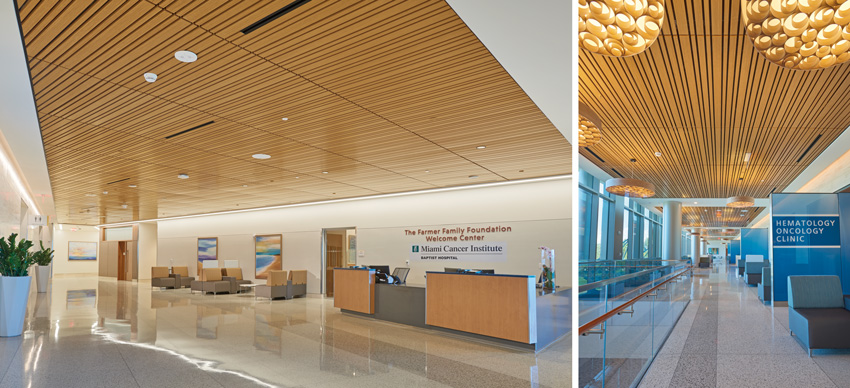New Acoustical Options in Specialty and Seamless Ceiling Systems
Wood Acoustical Ceilings
For some design schemes, the intent may be to use natural materials or bring a sense of nature indoors. Using exposed, finished wood for ceilings has been a popular solution for meeting those goals. However, creating a full ceiling out of custom millwork may not suit a construction budget, so turning to manufactured ceiling system that use either solid wood or wood veneer often proves to be a more cost-efficient and versatile solution.
Wood ceiling systems are available in a truly wide variety of types and options. At its simplest, wooden tiles with solid, coffered, or slatted configurations can be set in suspended ceiling grids. For a more continuous look, wood panels in a variety of widths and shapes can be installed. Those panels can have a solid appearance or a pattern that incorporates diffused slats, grilles, or other treatments in linear or radial patterns. Fully three-dimensional shapes are also possible, including curved floating panels or geometric shapes that protrude and recess across a ceiling plane in the fashion of ceiling clouds and canopies. In some cases, the wood products extend from the ceiling down onto a wall surface or fascia area as well, creating a continuous enveloping of the space characterized by the warmth of the natural wood. While many of these solutions can be done using standard products, it is also possible to have fully custom shapes, patterns, and styles produced. In all cases, the exact species of wood and its finished coloration can be specified to suit an overall design scheme by selecting from a wide range of standard and custom color options, including real wood veneers and exotic species. It is even possible to extend the look of a wood ceiling system to an exterior soffit or overhang for a continuous look between indoors and out.
Wood is often considered an ideal acoustical surface, but that varies depending on the type of wood, the use of the space, and other factors. The advantage of a manufactured wood ceiling system is that it can be produced to suit the specific acoustical needs of a room or space by using micro-perforated ceiling and wall panel surfaces. With this approach, panels appear to be nonperforated from a normal viewing distance but in fact have small perforations (on the order of 0.55 millimeter) to help control sound absorption and reverberation. Acoustic fleece can be factory attached to the back of these micro-perforated panels along with the option of acoustic insulation to provide a range of NRC values up to 0.80 for ceilings. Micro-perforated panels can be flat or curved and use a full range of wood species and finishing options.
From a sustainability perspective, wood is a renewable resource that is recognized by most green building rating systems for its comparatively low environmental impact and embodied energy. For true sustainability, the wood used should come from a sustainably managed forest with a certified chain of custody from forest to construction site as provided through independent organizations, such as the Forest Stewardship Council (FSC) or others. Manufacturers of wood ceiling systems offer such products. The sustainability aspects of wood ceiling systems can make a significant contribution to LEED credits or other green building rating systems.
Exposed Structure Acoustical Ceilings
Sometimes the design intent is to leave the roof or deck structure exposed and simply paint it. While that works visually for many buildings and is consistent with the overall design intent, it can have unwanted acoustical consequences, including decreased productivity and less-engaged employees, inhibiting students’ ability to learn or leaving patrons struggling to hear and be heard. In these cases, an acoustical treatment can provide a reduction in noise levels in such spaces. Such treatment can take the form of absorptive mineral fiber or fiberglass panels that are often sprayed the color of the deck so they are virtually unseen. These same treatments can also be used in I-beams and trusses. In other cases, treatment can take the form of suspended clouds and canopies or vertical baffles and blades.
The difference between the addition of acoustical treatments compared to the absence of them can be dramatic in spaces with exposed structures. Depending on the need, products are available that provide sound absorption between 0.75 and 1.00 NRC. Manufacturing partners can run reverberation time reports and recommend square-foot coverage of these absorptive elements to reduce reverberation times. This allows designers to achieve the best of both worlds by providing the right look and less noise in open ceiling spaces.
From a sustainability standpoint, all of the product options for exposed structures use the same materials as other systems already discussed. Therefore, they carry all of the same positive sustainability traits as the ones already noted.










